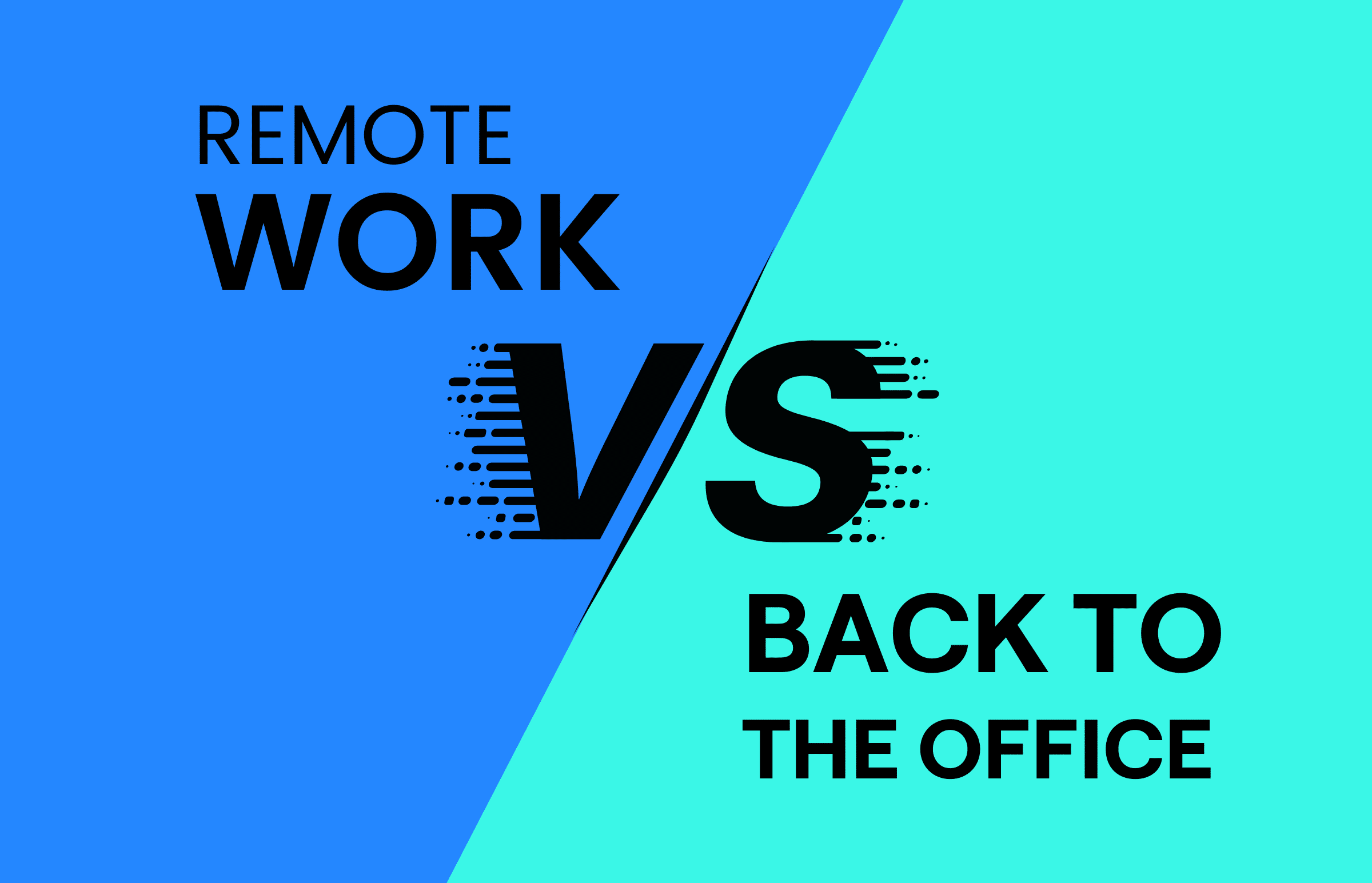Do you look forward to the end of remote working and workers going back to the office en masse once the pandemic is over? You might want to curb your enthusiasm.
Remote Work Statistics: What Do the Numbers Say?
While only around 15–16% of workers worldwide worked remotely before the onset of COVID-19, that percentage grew to 70–74% between September 2020 and March 2021.
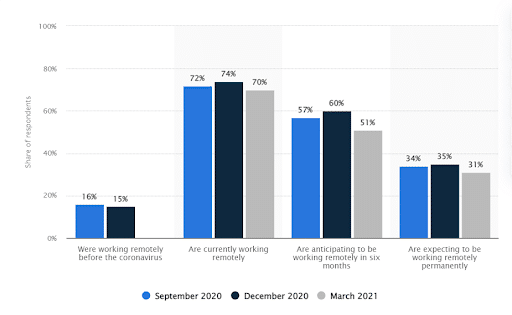
The pre- and post-COVID comparisons are even starker in the U.S., where a mere 6% of employees worked primarily remotely, and three-quarters had never worked from home prior to the pandemic. By May 2020, over one-third worked from home.
2022 Remote Working Forecast
In a recent analysis spanning 9 countries, 800 jobs, and 2,000 tasks, McKinsey found that:
- The hybrid work model is likely here to stay, especially for highly educated and well-paid professionals.
- Over 20% of workers could work from home three to five days a week without compromising productivity. That’s three to four times as many remote workers than before the pandemic.
- The IT and telecommunications sector is among the industries with the highest potential for remote working.
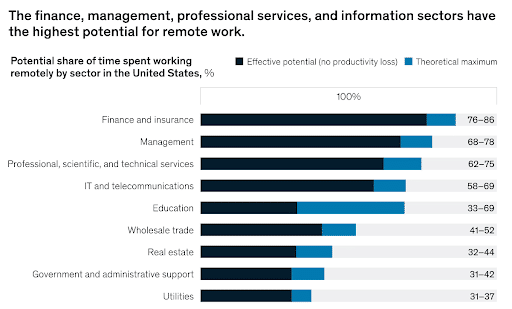
But there’s more.
A whopping 97% of remote workers don’t want to go back to the office full-time, and 61% prefer remote-only work models. A further 74% of professionals and 76% of entrepreneurs expect remote work to become standard.
Businesses Are Embracing Remote Culture for the Long Haul
You don’t have to take our word for it. Many business leaders have stated publicly that their organizations will be building a more remote-friendly company culture going forward.
According to Anne Boden, founder and CEO of UK-based Starling Bank, “[W]e’ve gone through this great realization that many people are far more effective working from home.”
The world’s tech giants have wasted no time and already updated their remote work policies.
As of June 15, 2021, all Facebook staff can ask to work from home full-time after the pandemic, and Google has approved 85% of requests to work remotely once its offices re-open fully.
Twitter takes things a step further and lets employees choose where they want to live and what arrangement they prefer — working from home, working in an office, or both. The new remote work policies seek to create a level playing field no matter where employees are based or how they work, with San Francisco no longer being the center of gravity it once was.
As Twitter CHRO Jennifer Christie puts it, “[T]here’s no turning back. We have forever left behind many of those former practices and habits that were so deeply ingrained in how we used to work. That now seems like 100 years ago, not 18 months ago.”
Are Hybrid Work Models a Viable Option?
For the most part — and to many people’s surprise — remote work programs have been an overwhelming success.
Consider the results of the latest PwC U.S. Remote Work Survey:
- In January 2021, 83% of employers believed that the transition to remote work had been successful for their organization.
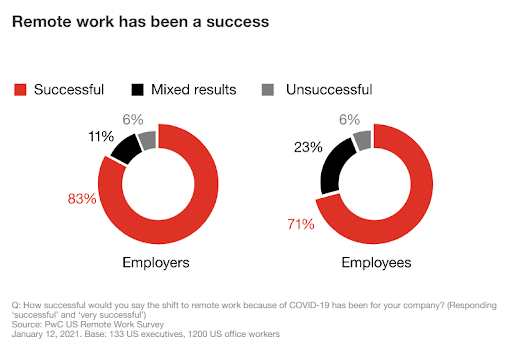
- Both workers (34%) and executives (52%) said that employee productivity is now higher than before the pandemic.
- Business leaders have various new investments in the works to support an increasingly remote work environment. These include digital tools for virtual collaboration (72%) and office space with enhanced video conferencing equipment (57%).
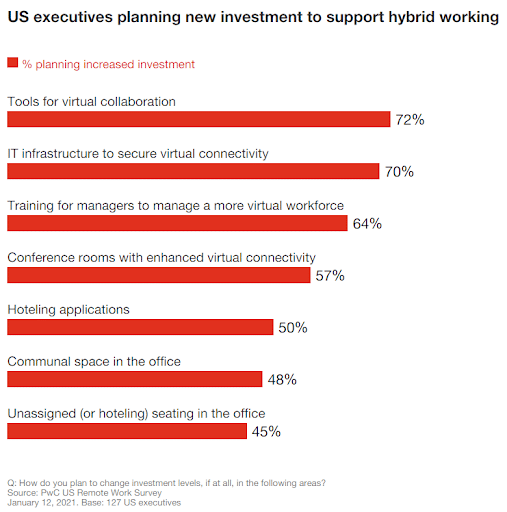
The Benefits of Working with Remote-First Software Companies
Here are just a couple of reasons you may want to look into remote outsourcing models such as nearshoring (also known as staff augmentation) or offshore software development:
1. It Boosts Team Happiness and Engagement
Remote work is certainly not without its challenges and may sometimes take a toll on employee mental health.
However, studies have also shown that when properly managed, work-from-home arrangements can contribute to a better work-life balance, reduce stress, increase productivity and autonomy, and boost employee morale and job satisfaction.
No wonder so many remote workers are unwilling to return to the office full-time. According to PwC, over half of employees want to continue working from home three days a week or more.
This has been our experience at Zartis as well. As long as team leaders stick to a few tried-and-tested managerial practices, remote teams stay satisfied, productive, and engaged — sometimes even more so than in-house employees.
To learn what these practices are, read our article on the 4 Ways to Keep Your Remote Development Team Happy.
2. It Enables Greater Flexibility and Scalability
Remote working models enable you to hire from a much larger pool of global talent. This way, you get to partner with highly skilled developers that may not be available closer to home.
You could cut back on costs, too. Developer wages vary across markets. You can also realize considerable savings by eliminating the need to set up physical workstations or putting your product to market faster with the help of a remote team.
Last but not least, partnering with an outsourcing vendor lifts a lot of admin and day-to-day managerial work off your shoulders. This enables you to redirect your attention — as well as a significant amount of money, resources, and human capital — to core business activities and revenue-generating tasks. As a result, your business can scale faster.
For more tips on choosing the right outsourcing software company and managing remote workers, check out our article, Remote Engineering Teams — What We’ve Learned.
How to Build Sustainable Remote Engineering Teams
If you’re planning to give remote software development a try, be sure to incorporate these best practices into your workflows:
- Decide as a team: Proactive communication is key here. Seek input from your developers and use it to design remote work options that work for them and your organization, whether fully remote or hybrid.
- Provide tools for collaborative work: Whether your developers are in the office or working from home, they need tools that enable remote communication and collaborative work in real time.
- Work with expert partners: If you’re new to remote development, you don’t have to go it alone. An experienced outsourcing vendor can help set up, manage, and grow your remote team with ease.
For a deeper dive into the topic, read our guide on How to Enable Sustainable Growth for Your Remote Engineering Teams.
Build Your Ideal Remote Developer Team with Zartis
The remote work environment is here to stay. Make the most out of the opportunities that are opening up by assembling your very own dedicated development team with Zartis.
Getting started is easy. Simply drop us a line to tell us about your business and its needs. We’ll take it from there.

